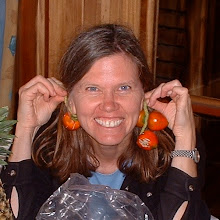Once every season, Mr. Rududu and I need to exit Costa Rica for at least 3 days and get a new tourist visa on reentry. These "visa vacations" have led us on many grand adventures, mostly to Central American countries. We also call these trips the Annual Roast-em Out since we usually go somewhere much hotter than Monteverde. This year we decided to keep things simple and go to Nicaragua. We went there ten years ago and had a very good time attending an intensive Spanish school in the lovely colonial city of Granada. However, an overwhelming memory of the trip was of extreme heat in March—and March is when we need to take our trip. This year we decided to go to the Island of Ometepe in Lake Nicaragua. It was such a great trip we are planning on going back in future years. See the end of the post for the nitty gritty details about the border crossing. Let's go right away to the pretty pictures.

Ometepe was formed by two volcanoes emerging from the very large Lake Nicaragua. Here's a view of them from the mainland restaurant where we waited for our ferry. A stiff breeze was keeping us comfortable while we nibbled on a tasty fried fish appetizer.
The hotel we stayed at is called
El Encanto and it did indeed enchant us. It has just 4 simple rooms and some dorm space. Our small room with private bath was very clean, had good mattresses, screens on the windows and a fan. Almost constant breezes kept us comfortable, although afternoons were a good time for a nap or some quality hammock time on the patio. The owner, Carlos, is developing a beautiful horticultural garden on the grounds instead of growing plantains as he used to. The hotel restaurant was excellent, with many fish, chicken and vegetarian options, all cooked from scratch.

The hotel has stunning views of the lake and the two volcanoes. This is the view from the dining room. Of all the advantages of El Encanto, what really makes it a great place to stay is Carlos. He speaks both English and Spanish and is helps all his guests with advice and logistics. The first morning we were there he guided the two of us on a birding hike down to a wetland area near the hotel. (Note: this is not a casual stroll. There's very little shade and the rough ground surface makes walking all morning tiring but we found it well worth the effort.) It's always a very special experience to go with a guide that is so enthusiastic about birds and has local knowledge of where to find them.

Highlights of the morning included hundreds of Black-bellied Whistling Ducks, some Double-striped Thick-knees, and a White-tailed Kite. By the end of our stay we had seen over 50 species. The most common bird near the hotel and a fun one to watch is the White-throated Magpie Jay. They are extremely active and led Mr. Rududu a merry chase as he tried to get a decent photo of one.
Our second day we spent the morning hiking part way up the Maderas Volcano to an overlook. Along the way we saw some of the many petroglyphs on the island, lots of monkeys, and some interesting birds. This howler monkey looked like he enjoyed a good rest in the heat of the day as much as we did.
The border crossing
Traveling in Nicargua can be both pleasant and inexpensive. The least pleasant part of going to Nicaragua from Costa Rica is the border crossing. The border area is about 1 Km long and there are numerous stops and checks you need to make, none of which are clearly marked. Long waits are common. An hour and a half seems typical but we've heard it can take 4 hours. Memories of waiting in very slow moving lines at temperatures of about 90F/32C had me dreading it. Thus, we were a little disoriented when we got out of the cab that brought us from Monteverde and found no line at all at the Costa Rican immigration office.
If you arrive on an international bus, such as the Tica Bus or Transnica, the bus employees will tell you exactly where to go and what to do. The buses are comfortable and inexpensive. A down side of the bus is that you arrive with a whole crowd of other people that instantly make the line a lot longer. We were lucky to arrive when there were no buses going through. We were told that they seem to be concentrated between 11 and 1; we arrived at 11 in each direction.
There are lots of guys who want to help you navigate the border if you aren't on a bus. We found it worth a small tip to have one give us the forms and show us where to go. The forms are free, but only available at the head of the line; having them in advance gives you time to fill them out. On the way into Nicaragua, our helper on the Nicaraguan side also was a broker for finding a taxi, although I'm sure we could have done that on our own—and probably found one with seat belts. A cheaper option is to take local buses to and from the border.
An important advantage of adopting a helper is that all the other ones leave you alone. You can take a pedicab part of the way within the border area to decrease how far you need to walk. It's a nice little splurge—think of it as helping the local economy. It only took us 30 to 35 minutes to make our crossings. The high season in Nicaragua is from December to mid-January and Semana Santa (Holy Week). Border crossings at those times are likely to take a lot longer.




























